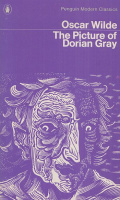categories
- Traffic and Vehicles Catalogue
- socreal.catalog
- Advertisement Catalogue
- Photo Catalogue
- Chinese and Japanese Catalogue
- New Holy Card Catalogue II.
- 12 interesting old books
 Books
Books
 Bibliophil
Bibliophil
 Antiques
Antiques
 Engraving
Engraving
 Maps
Maps
 Photos
Photos
 Antique Papers, Small Prints
Antique Papers, Small Prints
 Posters
Posters
- Circus
- Modern Graphics
- Socialist Realism
- NER Propaganda
- Others
cart
Cart is empty
You've not logged in
Wilde, Oscar : The Picture of Dorian Gray
- description
- additional information
Series: Penguin Modern Classics.
The Picture of Dorian Gray was Oscar Wilde's only novel (he's mostly famous for his plays, poetry, and short stories), but what a novel it is! In the century or so since its initial publication in 1890, the fate of poor Dorian Gray has taken hold of the popular imagination. Dorian's story plays upon the timeless theme of selling one's soul in exchange for earthly pleasures (see other classics like Goethe's Faust or the musical Damn Yankees), and the inevitable disaster that results. Wilde's version of this narrative is particularly notable for its embrace of the hedonistic lifestyle of the Decadents, a late nineteenth century artistic movement that prized beauty and aesthetic experience over everything else. Dorian Gray and its protagonist have become synonymous with the pursuit of pleasure, regardless of its moral consequences.
The novel raised quite a blizzard of scandal in its day, and had critics denouncing Wilde for what they perceived to be his own innate immorality – and as a result, he responded with the famous "Preface" to the novel (published in its second edition) that explained his artistic beliefs. (Check out more discussion of the Preface in "What's Up with the Epigraph?") Altogether, The Picture of Dorian Gray reveals Wilde's philosophy more than any of his other works; reading it is an essential key to understanding his artistic mission as a whole.
The Picture of Dorian Gray was Oscar Wilde's only novel (he's mostly famous for his plays, poetry, and short stories), but what a novel it is! In the century or so since its initial publication in 1890, the fate of poor Dorian Gray has taken hold of the popular imagination. Dorian's story plays upon the timeless theme of selling one's soul in exchange for earthly pleasures (see other classics like Goethe's Faust or the musical Damn Yankees), and the inevitable disaster that results. Wilde's version of this narrative is particularly notable for its embrace of the hedonistic lifestyle of the Decadents, a late nineteenth century artistic movement that prized beauty and aesthetic experience over everything else. Dorian Gray and its protagonist have become synonymous with the pursuit of pleasure, regardless of its moral consequences.
The novel raised quite a blizzard of scandal in its day, and had critics denouncing Wilde for what they perceived to be his own innate immorality – and as a result, he responded with the famous "Preface" to the novel (published in its second edition) that explained his artistic beliefs. (Check out more discussion of the Preface in "What's Up with the Epigraph?") Altogether, The Picture of Dorian Gray reveals Wilde's philosophy more than any of his other works; reading it is an essential key to understanding his artistic mission as a whole.
| condition: |      |
| category: | Books > Foreign Language Books > Books in English > |
| publisher: | Penguin Books, (1969) |
| item number / ISBN: | 0027767 |
| binding: | paperback |
| pages: | 247 |
| language: | English |



























































 Telefon:
Telefon: E-mail:
E-mail:







